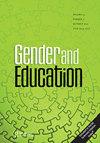澳大利亚学校性别不平等:“这个项目不是要把男孩变成女孩”
IF 1.9
3区 教育学
Q2 EDUCATION & EDUCATIONAL RESEARCH
引用次数: 3
摘要
摘要本文是一份绘制澳大利亚教育性别平等政策的地图。我认为,根深蒂固的性别歧视、种族主义、同性恋/跨性别恐惧症和厌恶女性的做法,自20世纪70年代实施首个性别平等项目以来,并没有显著改变,尽管投入了大量资金、进行了大量研究,并声称政策发生了变化。我的制图有意引起人们对政策材料如何影响教育中不稳定群体的关注;那些仍然被坚定地归类为女孩的学生,以及那些认为自己是黑人、土著、有色人种(BIPOC)、性别多样化以及女同性恋、男同性恋、双性恋、变性人、酷儿、双性人(LGBTQI+)的学生的交叉劣势。我认为,性别不平等在我们的学校中继续盛行,是父权异性恋教育政策的结果,这种政策有效地将性别从平等的等式中移除。目前,性别不平等现象隐藏在人们的视线之中,性别和基于性别的暴力和骚扰在学校中仍然普遍存在,并暗中与实践和程序纠缠在一起。本文章由计算机程序翻译,如有差异,请以英文原文为准。
Erasures of gender in/equity in Australian schooling: ‘The program is not about turning boys into girls’
ABSTRACT This paper is a making, a cartography that maps gender equity policy in Australian education. I suggest that entrenched reductive sexist, racist, homo/transphobic and misogynistic practices have not significantly shifted materially since the implementation of inaugural gender equity programs in the 1970s, despite the investment of much money, research and purported policy changes. My cartography intentionally draws attention to how policy material impacts precarious bodies in education; those that remain firmly classified as girls and the intersecting disadvantages of students who identify as Black, Indigenous, people of color (BIPOC), gender diverse, and Lesbian, Gay, Bisexual, Transexual, Queer, Intersex (LGBTQI+). I propose that gender in/equity that continues to flourish in our schools is a consequence of an ongoing patriarchal heteronormative education policy that has efficiently removed gender from the equity equation. At present gender, inequity is hidden in plain sight and gender and sex-based violence and harassment remain rife in schools, covertly entangled in practices and processes.
求助全文
通过发布文献求助,成功后即可免费获取论文全文。
去求助
来源期刊

Gender and Education
EDUCATION & EDUCATIONAL RESEARCH-
CiteScore
5.20
自引率
9.10%
发文量
31
期刊介绍:
Gender and Education grew out of feminist politics and a social justice agenda and is committed to developing multi-disciplinary and critical discussions of gender and education. The journal is particularly interested in the place of gender in relation to other key differences and seeks to further feminist knowledge, philosophies, theory, action and debate. The Editors are actively committed to making the journal an interactive platform that includes global perspectives on education, gender and culture. Submissions to the journal should examine and theorize the interrelated experiences of gendered subjects including women, girls, men, boys, and gender-diverse individuals. Papers should consider how gender shapes and is shaped by other social, cultural, discursive, affective and material dimensions of difference. Gender and Education expects articles to engage in feminist debate, to draw upon a range of theoretical frameworks and to go beyond simple descriptions. Education is interpreted in a broad sense to cover both formal and informal aspects, including pre-school, primary, and secondary education; families and youth cultures inside and outside schools; adult, community, further and higher education; vocational education and training; media education; and parental education.
 求助内容:
求助内容: 应助结果提醒方式:
应助结果提醒方式:


